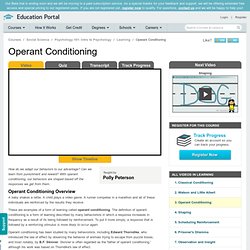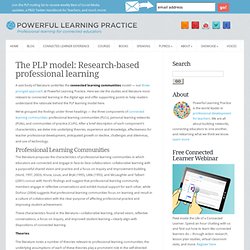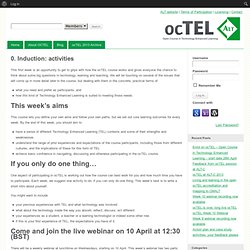

Elizabeth Pearce
Assistant Professor in the Department of Special Education, Lewis University, Romeoville IL
Operant Conditioning - Free Intro to Psychology Video. Last revised: March, 2014 Acceptance of Terms Please read this Terms of Service Agreement ("Terms of Service", "Terms of Use") carefully.

These terms apply to Education Portal and its related websites owned and operated by Remilon, LLC ("Education Portal,", "Site", "Sites", "our", "us"). Education Portal provides the Services, which are defined below, to you subject to the following Terms of Service, which may be updated by us from time to time without notice to you.
The PLP model: Research-based professional learning. A vast body of literature underlies the connected learning communities model — our three-pronged approach at Powerful Learning Practice.

Here we cite the studies and literature most relevant to connected learning in the digital age and offer supporting points to help readers understand the rationale behind the PLP learning model here. We’ve grouped the findings under three headings — the three components of connected learning communities: professional learning communities (PLCs), personal learning networks (PLNs), and communities of practice (CoPs). After a brief description of each component’s characteristics, we delve into underlying theories, experience and knowledge, effectiveness for teacher professional development, anticipated growth or decline, challenges and dilemmas, and use of technology.
Stages of PLN adoption. Why (And How) You Should Create A Personal Learning Network. What Is A PLN? Through the use of my own Personal Learning Network (PLN) , I came across several great examples that both define what a PLN is, and explain the value of creating one for yourself. According to a wikispace about creating PLNs, How to Create a Robust and Meaningful Personal Learning Network [PLN]
This post describes how educators can develop a personal learning network that supports meaningful and relevant learning.
![How to Create a Robust and Meaningful Personal Learning Network [PLN]](http://cdn.pearltrees.com/s/pic/th/meaningful-personal-learning-49716309)
The MOOC, Education Technology & Media, etmooc, is used here as a working example of how to develop a PLN. “My Personal Learning Network is the key to keeping me up-to-date with all the changes that are happening in education and how technology can best support and engage today’s students.” Brian Metcalfe: teacher, blogger at lifelonglearners.com A visual image of participants in an open, online course- etmooc, which shows the potential to find and create personal connections as part of one’s PLN. (image credit: Alec Couros)
WordPress › Blog Tool, Publishing Platform, and CMS. 50 Must-See Blogs For Special Education Teachers. While being a teacher is never easy, working with students in special education comes with some unique challenges. From writing lengthy IEPs to working closely with parents and other teachers, it takes a calm, collected, organized, confident, and very special person to work with students who often need a great deal more support and assistance than their peers to succeed. Yet even the best special education teachers can use a little guidance, inspiration, and information to help them to be even better at what they do. That’s just what the 50 blogs we’ve collected here can do. Special Education Teaching Tips and Strategies These blogs are written by teachers and educational professionals who share their ideas, tips, tools, and advice for working with special education students.
Reality 101 : The Council for Exceptional Children maintains this blog along with the help of several special education teachers who share their experiences and advice. WIkis. Wikis for Teachers. GlobalReadAloud - Flat Stanley Map. Online Team Collaboration. The professional network. LinkedIn.
COURSERA. MOOC Reviews & Ratings. Canvas Network Reviews. 7 Things You Should Know About MOOCs. Education. 0. Induction: activities. This first week is an opportunity to get to grips with how the ocTEL course works and gives everyone the chance to think about some big questions in technology, learning and teaching.

We will be touching on several of the issues that will come up in more detail later in the course, but dealing with them in the concrete, practical terms of what you need and prefer as participants, andhow this kind of Technology Enhanced Learning is suited to meeting those needs. This course lets you define your own aims and follow your own paths, but we set out core learning outcomes for every week. By the end of this week, you should aim to One aspect of participating in ocTEL is working out how the course can best work for you and how much time you have to participate. You might want to include There will be a weekly webinar at lunchtime on Wednesdays, starting on 10 April. Activity 0.1: My big question (45 mins) Twitter. Top 14 Educational Technology Tweeters to Follow. Elizabeth Pearce / Pinterest. Paper.li – Be a publisher. Feedly. feed your mind.
NETVIBES. Facebook. ASCD EDge: A Professional Networking Community for Educators. Educators - Project RED. As an in-the-trenches educator, you see the vast potential for technology in the classroom.

But how do you help your school and district embrace the full spectrum of possibilities to ensure a successful implementation? Project RED offers tools and resources to support your needs. Project RED conducted the first and only national research study focusing on academic and financial benefits of educational technology. Our research of 1,000 schools revealed key findings for the effective integration of technology in schools-- findings that show a replicable design for reducing costs and increasing student achievement.
Let us show you how technology can effectively benefit all students. Professional learning strategies In order to see student achievement increase and to realize cost benefits from technology, all staff, from the leadership to the classroom teacher, must be engaged in and committed to technology. Practical, research-based method. Home: Personal-Learning-Networks for Institutions & Enterprises. EdWeb. Classroom 2.0. The Educator's PLN - The personal learning network for educators. Backchannelling of conferences.
Twijector - real-time twitter wall (back channel) for conferences and events. Wiffiti - Gather & Display Feedback via Text. Boards. Classroom 2.0 LIVE! - Home.